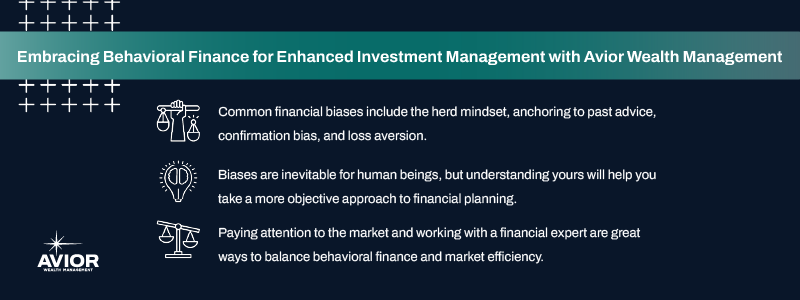Embracing Behavioral Finance for Enhanced Investment Management with Avior Wealth Management
We all have biases that drive our decision-making, and that includes financial decisions such as investment management. Learn how psychology and finance intersect with investment strategies and some of the most common financial biases and how to address them.

Psychological factors influence just about every decision you make, whether you’re aware of it or not. This is also true for finance – our emotions and inherent biases govern our financial decisions, which is referred to as behavioral finance. An important part of financial planning is understanding how emotions guide your decisions and how overcoming biases can lead to greater success.
We consider understanding and mastering behavioral finance to be vital to your overall wealth management approach. Discover the most common financial biases and see if any of them are influencing your financial decision-making. By doing this, you can embrace behavioral finance for enhanced investment management.
Understanding common financial biases and investor psychology
Behavioral finance examines the underlying psychological factors that influence your financial planning. By addressing these factors, you will better understand your feelings about money and what is most important to you.
The following are examples of biases that commonly affect financial decisions like investment management:
Mental accounting: This bias shows up as treating money differently based on subjective criteria. For example, you may view receiving income from a tax refund with a different attitude than income from your regular paycheck.
Herd mindset: This is an approach where you follow the actions and decisions of a larger group around you. An example may be collectively buying or selling during market rallies or crashes.
Emotional gaps: There is often a gap between your emotional state and financial decision-making, and it’s not easy to recognize. This can be problematic when you make a rash decision because of excitement or fear.
Anchoring: An anchoring bias develops when we continue to rely on one piece of advice or information for subsequent financial decisions, even when it no longer applies. An example would be holding onto a stock at a loss because of its initial purchase price.
Self-attribution: This bias can be tricky. You may attribute a win or loss to factors like your financial aptitude or the greater market, when in fact it could have happened for another reason.
Confirmation bias: As humans, we often want to confirm our existing or long-held beliefs. This leads us to favor information that helps us sustain our beliefs, so we easily ignore news or advice outside of that belief like negative news about a favorite stock.
Experiential bias: We all bring our past experiences to the present. These experiences can have a great influence on our financial decision-making, like how much risk we are willing to take because of a past success or failure.
Loss aversion: This bias is when you would rather avoid a loss than acquire equivalent gains. Examples would be selling a winning stock too early and holding losing stocks (known as the disposition effect).
Familiarity bias: You may be very familiar with certain investments, so you continue to pursue them instead of expanding your portfolio. You may feel comfortable doing what is familiar, but it can lead to under-diversification.
You may recognize several of these biases in your finance-related behavior. While they aren’t always negative, they can get in the way of smarter decision-making and reaching your goals effectively.
Next, find out what you can do about these biases.
How to balance behavioral insights and market efficiency
Fortunately, by doing a little bit of digging to uncover financial biases and past behaviors, we can address them and improve how we approach investment planning. You can start to balance your behaviors, fears, and beliefs with best practices that lead to market efficiency.
These strategies will help you achieve that balance:
1. Uncover the reasons behind the insights
Once you uncover your behaviors, start to break down the “why” behind your thinking. Maybe you have been uncomfortable with taking on too much risk because of the way your parents approached finances when you were a child. Or, maybe you experienced a big loss early on that you don’t want to repeat, so you’re afraid to take any risk again.
2. Break patterns that get in the way of success
By embracing behavioral finance, you will start to notice which decisions are standing in the way of the results you want to see. Maybe you allow yourself to take more risks, or perhaps you better balance your portfolio so you have some more conservative investments to rely on after getting hit too many times.
3. Pay attention to the market
While you don’t always want to take on the herd mentality and act quickly when everyone else does, it’s still pertinent to watch market trends and act accordingly. Educate yourself by listening to experts and thought leaders. You’ll start to learn how everything ebbs and flows as you gain experience, so you can start to make more informed investment decisions.
4. Work with a financial expert
Talking through your behavioral discoveries with a financial advisor can help you understand yourself better so you can let go of biases and beliefs that aren’t serving you. An advisor can help you break down what a properly balanced investment portfolio looks like. They can also help you understand what the market is doing and why.
Avior financial advisors will help you discover the biases you carry, why you may carry them, and where they’re getting in the way of financial planning. They will help you address how your psychological factors and emotions impact your investment strategy.
The pivotal role of behavioral finance in investment management
Financial decisions aren’t made in a vacuum. You make investment decisions based on your goals and priorities, but also your fears, biases, desires, assumptions, and experiences. Behavioral finance helps you break down these factors so you can both understand your behavior and address issues to improve your financial plan.
Work with Avior when you are ready to improve your investment strategy. Our team is here to help you meet your financial goals, both now and in the future.
Disclaimer: Nothing contained herein should be construed as legal or tax advice. Avior and our Advisors will work with your attorney and/or tax professional to assist with your legal and tax strategies. Please consult your attorney or tax professional with specific legal and/or tax questions. Investment Management and Financial Planner are offered through Avior Wealth Management, LLC, an SEC-registered investment advisor. Past performance is not a guarantee of future results. Investments are subject to loss, including the loss of principal.
No Comments
Sorry, the comment form is closed at this time.




